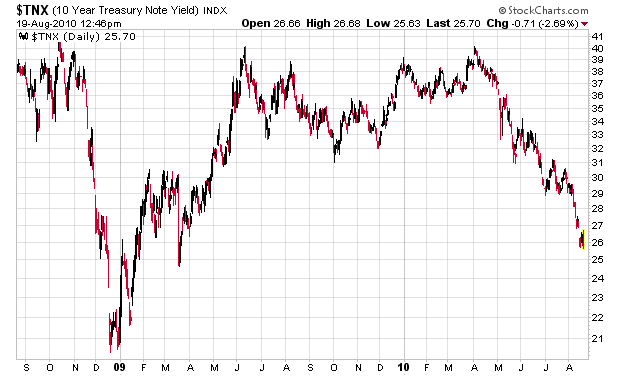After alluding to disposing of a long corporate bond position, I received some comments as to what the exact ticker is of the issue in question. There were enough hints in the post to figure out the product, but I will be more explicit in this post.
Now that I have completely disposed of the position today, the ticker in question is (NYSE: HJR). This is one (of many, many) examples of an exchange-traded structured product. The specific structure is a trust that has a single asset – corporate senior bonds of Limited Brands (6.95% coupon, maturing March 1, 2033). The trust’s mission in life is to distribute income coming out of that bond. The trust itself has $25,340,000 worth of 6.95% corporate bonds and the distribution is at a 7.00% rate.
You can read the exact specification of the trust by reading its prospectus.
Effectively you are investing in a corporate bond that is exchange-traded. The payout times are identical to the bond, with the exception of the coupon (7.00% on the trust vs. 6.95% with the corporate bond) and that trades do not incur interest expense/revenue for a purchase/sale of securities. An investor purchasing one unit of HJR will receive a $0.875 payout every March 1 and September 1 until March 2033, where they will receive a $25.875 payout.
At the current transaction price of $24.40, an investor has a 7.2% current yield on investment, or about a 7.5% yield to maturity for a 22.6 year term.
There are slightly different risks involved with the structured product. The largest change is that the structured products have a “call provision” where the unitholder, if held in sufficient quantity, can redeem the trust in exchange for the underlying bond. This call provision ensures that there is an effective cap on the unit price, even if the underlying bond trades at a premium.
There are a couple hundred of these products trading on the exchanges – some are extremely illiquid, and in the example of HJR, it is lucky to have $50,000 par value traded daily. The spread is typically 40 cents.
As I have indicated before, I have recently liquidated my entire position in HJR as I do not feel the risk/reward ratio is right for my portfolio. Other investors that are looking for a stable 7.2% yield on a senior corporate security could consider HJR. It is still a far, far more inferior option at present than buying the actual corporate debt, which is priced at around 90 cents. Since HJR is trading around 97 cents on the dollar, I am very puzzled at the high price and hence sold my position. The bid is obviously from an irrational retail source.
There are other structured products carrying the exact same bond as collateral, and they are trading at more reasonable prices. If the products were marginable, there would be an obvious arbitrage opportunity.
Exchange-traded structured products are very research-intense. Although most of them have standardized provisions, there are some that have odd-ball provisions that require you to look at the prospectus of each and every security that you are considering. Once you have cleared the research hurdle, however, they are worth looking at. In late 2008 and early 2009, these products were being thrown out the windows of financial intuitions. At the depth of the financial crisis, HJR was trading for $8.40 (33.6 cents to par) and suffice to say, I thought this was one of the greatest opportunities the market was offering especially in consideration with the risk taken (the seniority of the bond ranks you ahead of common shareholders).
Although you would have done slightly better with an equity investment at the same time, you earned your capital gain with a significantly lower level of risk, in addition to having the luxury of having a well-defined exit point (at the lastest, the maturity date). You were also being paid a handsome sum of money to wait.
In the case of HJR, and in the case of a lot of other asset-backed securities that give out a yield, it is close to the time where it is worth liquidating the positions. As the 10-year bond yield is heading toward record lows, chasing yield will become more and more dangerous.
